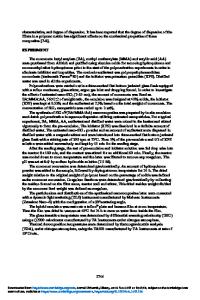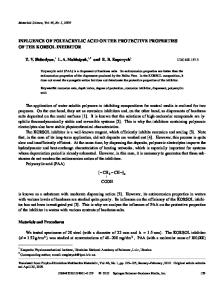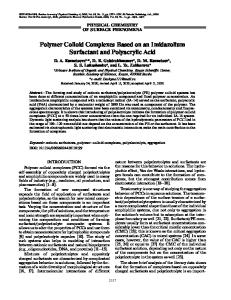Optical properties of gold-containing Poly(acrylic acid) composites
- PDF / 429,261 Bytes
- 6 Pages / 414.72 x 648 pts Page_size
- 2 Downloads / 288 Views
Scon'esponding 2
author
now at Balzers Display Technology Division, Liechtenstein now at Toulon University 79
Mat. Res. Soc. Symp. Proc. Vol. 501 0 1998 Materials Research Society
poorly soluble gold hydroxide [4]. Optical transmission spectra were measured at different reaction times on a Perkin Elmer Lambda 6 spectrometer. The dynamic rheologic properties of the samples were measured on a Rheometrics RDA II apparatus. Viscosity and elasticity of solution films with a thickness of approximately 0.5 mm were measured between two polymeric or glass plates. The sample solutions were protected by silicone oil against drying out at the plate edges. The strain was varied at a rate of 10 rad/s, and was kept low enough not to destroy the gels. Photoluminescence (PL) and photoluminescence excitation (PLE) spectra were measured on a Hitachi FL-4500 fluorimeter. All experiments were done at a room temperature of 22'C. Solid films were produced by spreading films on glass substrates and drying in air at a temperature of 80'C. 2. RESULTS AND DISCUSSION When aqueous solutions of PAA are mixed with gold chloride, they form a gel which then turns slowly from yellow transparent to reddish-brown color. The latter is supposedly associated with the formation of gold nanoparticles. Due to both the high polymer content and the instability of gold chloride under the electron beam, this particle formation cannot be observed directly by transmission electron microscopy. In this paper, the kinetics of this reaction are investigated using various other experimental techniques. 2.1. Optical transmission spectroscopy Typical evolution of optical transmission spectra for aqueous solutions are shown in figure 1. The different features visible in the spectra can be related to different components which are present in the solutions. A peak found around 450 nm in the initial AuC13 solution is non-stoichiometric and appears in concentrated solutions only [5]. Figure1: Absorption spectra of 25 wt. % 90000 Mw PAA solutions after different times after addition of 2.6 mg/ml AuCI3. The spectra were taken after 30 s (a), 7000 s (b), 22000 s (c), 133000 s (d), and i390000 s (e). Spectrum (a) is rigidly shifted downwards by one unit. The peak associated with high AuCl3 concentrationsis continously shifting towards the blue with time, indicating a decrease of AuCl 3 concentration (b). The gold plasmon is appearingafter two to three (c). The subsequent increase of the absorption coefficient, which is almost independent of the Iwavelength (de), is due to particle ,aggregation.
4
e 3 E 0'
d
2 C0 C0 1-
C
(.0
Data Loading...











